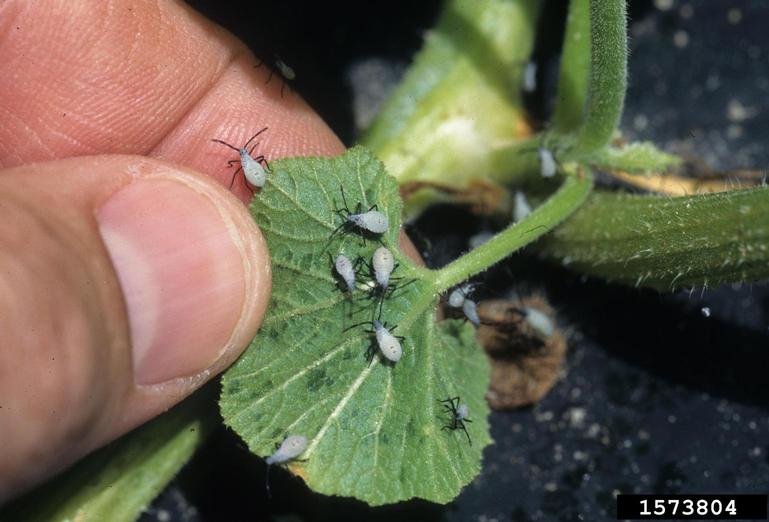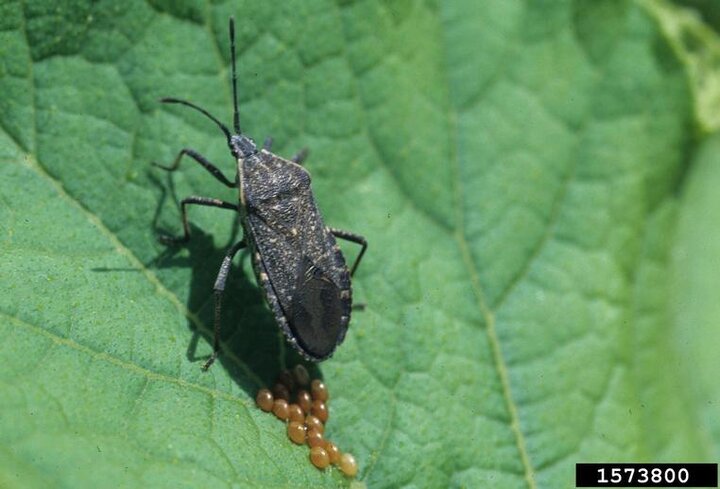Sarah Browning, Nebraska Extension Educator

Squash bugs are a common pest with a preference for winter squash and pumpkins.
Squash bugs are a common pest of cucurbits, with a preference first for winter squash and pumpkins, followed by gourds, summer squash and melons, and occassionally cucumbers. Among squash, winter varieties such as hubbards and marrows, are most severely effected.
Now is a good time to scout your vegetable garden for adults, nymphs and eggs, and take steps to control them.
Damage
Both adults and nymphs feed on plant leaves and stems by sucking sap from the plant tissues. While feeding, they inject a toxic substance into the plant, which causes yellowing of the leaf foliage and eventually wilting and death of the plant. This condition is called Anasa wilt of cucurbits.
Squash bugs are also the vector for a recently recognized wilt of cucurbits called Yellow Vine Decline. Plants are infected with the bacteria through feeding of squash bugs. Symptoms usually begin with the plant turning yellow. When cut, affected stems show a brown ring of discoloration in the phloem cells. Eventually affected plants wilt and die.

Description & Lifecycle
Adult squash bugs are 5/8 inches long and approximately 1/3 inch wide. The adults are winged, brownish black insects, sometimes mottled with gray or light brown on the back, and have a flat back. They have an unpleasant odor when crushed.
Adults overwinter in leaf litter and debris, emerging in spring as the cucurbit vines begin to grow. After mating, females lay clusters of brick-red eggs in the angles between leaf veins on the underside of the leaves. Hatching occurs in 7-14 days. Young nymphs have a green abdomen, and crimson head, thorax and legs. Older nymphs are light gray with black legs.
One generation of insect occurs each year, but the extended egg-laying period of female insects results in all life stages occurring throughout the summer months.
Squash bug adults and nymphs hide on the undersides of leaves, near the crown of the plant, under clods of dirt or any other protective cover. They are gregarious, feeding in groups, and quickly move away when disturbed.
Control
Early detection of squash bugs is vital to effective control. Adults are very difficult to kill and can kill entire plantings if not controlled.
Begin scouting plants for adults insects and egg masses as soon as plants emerge in spring. One egg mass per plant indicates control measures are needed. Begin control as soon as insects are found, and prevent large populations from developing.
1. Cultural Control- Remove and bury or burn all garden debris in the fall to eliminate insect overwintering sites. Mow vegetation around the garden or planting field to minimize insect habitat. Plant varieties of squash and pumpkin that are resistant, including Butternut, Royal Acorn and Sweet Cheese.
2. Manual Control- Home gardeners can handpick adults and crush egg masses to reduce insect numbers in the garden. Place boards under plants, to provide aggregation sites for the insects. This can simplify collecting and destroying of the insects.
3. Chemical Control- Adults are difficult to kill with insecticides, so control should be targeted at the nymphs to prevent them from surviving. Homeowners can spray plants with an insecticide, such as Sevin (carbaryl) or Eight (permethrin), being sure to target the undersides of leaves. Reapply the insecticide as directed on the label.
Always read and follow all directions and precautions on the insecticide label.
Image right - Gerald Homes, Strawberry Center, Cal Poly San Luis Obispo, Bugwood.org.
Search Our Archive
Associated Video
Squash Vine Borer
Nebraska Extension Urban Entomologist Jody Green talks about managing squash vine borer